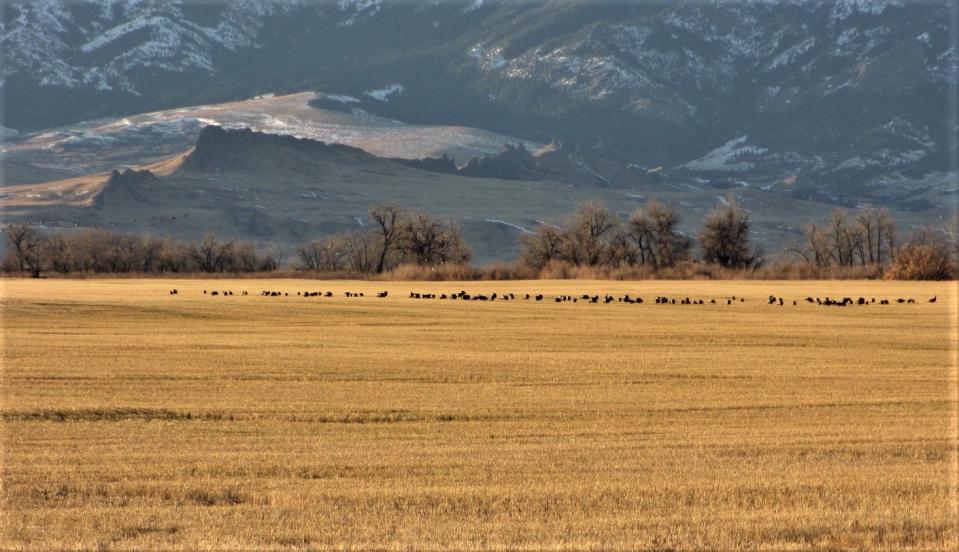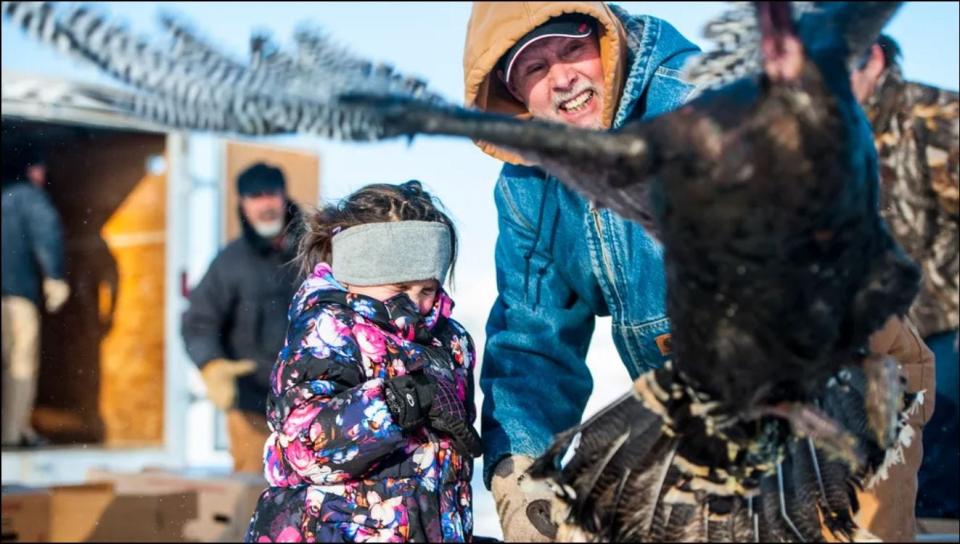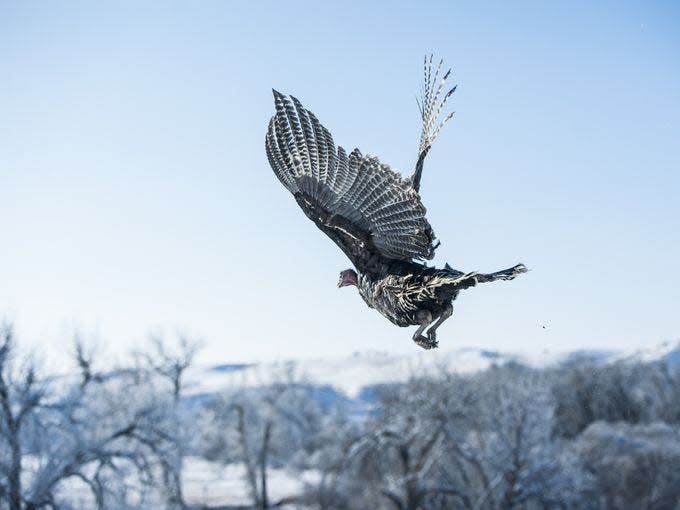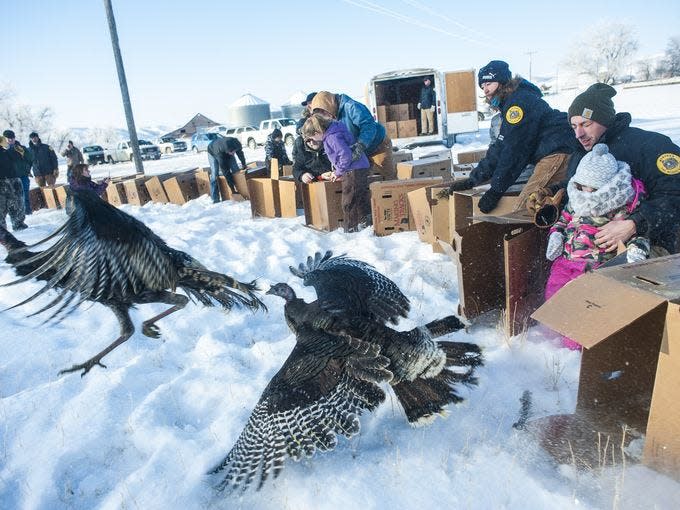Wild turkeys now common in places where they didn't exist 20 years ago
At this time of year most people’s thoughts on turkeys tend to center on how to pair them with mashed potatoes and pumpkin pie. While feasting on a farm raised turkey roasting in the oven is undoubtedly one of the most cherished traditions of Thanksgiving, seeing a wild flock in a grain field, river bottom or even strutting across front yards in Great Falls has its own charm.
In terms of sheer bulk, wild turkeys are among the largest bird species in North America. An adult male can weigh up to 24 pounds and be 49 inches long, a size rivaled only by the Trumpeter swan and the California condor. While they appear rotund and awkward in their gait, turkeys are fast. When startled they can bolt at a run equal to that of an elite track athlete, or burst into flight where they can reach speeds of 55-miles-per-hour, though only for short distances.

It’s a sight most central Montanans have come to experience at one time or another, but in truth its a recent occurrence. Up until the 2010s almost no wild turkeys strutted the fields of northcentral Montana. Through a successful relocation program managed by Montana Fish, Wildlife and Parks (FWP), wild Merriam’s turkeys are now becoming a common site throughout much of the area. The program has been so successful that two years ago FWP changed its regulations to offer a general turkey hunting season in several northcentral Montana counties.
“Back in 2007 we didn’t have turkeys around much of Cascade County, Teton or Chouteau Counties at all,” said. Cory Loecker, wildlife biologist for FWP Region 4. “There were a few in the Little Belt Mountains and a population over in Fergus County but around here their weren’t any.”
A remarkable comeback

While turkeys are synonymous with the Pilgrims and colonial America, they are not native to Montana. Their original range was limited to the hardwood and conifer-mixed hardwood forests east of the Great Plains.
By the early 1940s wild turkey populations in the U.S. had crashed, the victim of rapid development, timber harvesting, and unrestricted hunting. The National Wild Turkey Federation estimates that only 30,000 wild turkeys remained in the United States at the beginning of the Second World War. Today, after 70 years of conservation efforts, the country’s wild turkey population stands at around 3.5 million birds, and they inhabit portions of every state except Alaska. Much of that restoration was paid for by hunters through hunting license fees, a federal excise tax on the sale of firearms and ammunition, and from contributions from organizations like the National Wild Turkey Federation.
“It is one of the most remarkable comebacks in the history of wildlife conservation,” National Wildlife Federation biologist say.
In the mid-1950s the Montana Department of Fish and Game released a total of 57 Merriam’s turkeys from Colorado and Wyoming into areas of central and southwestern Montana. Today, Montana’s population of Merriam’s turkeys is estimated to be around 120,000 birds.
In the past, surplus turkeys from southeast Montana were likely used to bolster populations in northcentral Montana, but most of the state’s flocks were concentrated in southeastern and eastern Montana, along with a few pockets in the northwestern corner of the state. That began to change in 2008, when 94 turkeys were released on the Missouri River near Cascade. Cory Loecker was at the center of that initial transplantation effort.
“I used to work in the Pine Ridge District of Nebraska which had a lot of turkeys at that time,” he recalled. “So, we moved some Merriam’s turkeys from within Montana and outside Montana into Cascade County on the Missouri River. They took off really well. Some moved through town (Great Falls) and on up onto the Sun River.”
FWP’s initiative to bring wild turkeys to northcentral Montana was received with enthusiastic support from conservation and sportsmen’s organizations like Pheasants Forever, the National Wild Turkey Federation, the Russell Country Sportsman’s Club and Safari Club International.
The release was so successful that FWP quickly established a limited spring hunt by special permit only. The next major phase of turkey introduction began seven years later.
“In 2015 and 2016 we did another environmental assessment and worked with some landowners along the Teton, Marias, and Missouri rivers to release turkeys in habitat by Fort Benton, Loma and north of Carter,” Loecker said. “Locations for the turkey releases were chosen because landowners were willing to have them and allow hunting, and because it’s good turkey habitat. If you’ve been up in that country, you’ll see turkeys often now.”
A remarkable bird

In Montana, wild turkeys’ preferred habitat is open forest interspersed with grassland and brushy draws. In the summer turkeys feed on insects, berries, and flowering plants. According to the Nature Conservancy, they are “quintessential omnivores” snapping up grasshoppers, ground beetles, flies, caterpillars, ants, and crickets whenever they have the chance.
“They move about the woods like a pack of velociraptors,” the Nature Conservancy’s report states, “thrashing up the leaf litter and eating anything that moves.”
In the winter they can scratch for grain in nearby fields. In locations where turkey populations become too successful this can prove to be a nuisance to local farmers.
“Especially if a landowner has barley bales,” Loecker observed. “They get up on top and scratch the heck out of them. They’ll tear them apart, so we try to work with landowners that may have an issue with that. We fence them out and put some netting over the top of the bales, or if there’s too big of a flock, we can trap them and move them.”
Not to be confused with their stupid cousin the domesticated turkey, wild turkeys are well known for their intelligence. According to biologists working with the National Wild Turkey Federation, wild turkeys form complex social organizations, have a refined "language" of yelps and cackles, and frequently develop unique personalities that include expressions of affection toward one another.
Their downfall is their intense curiosity and love of grain, a quality that FWP’s Region 4 biologists have learned to exploit when trapping and transporting nuisance flocks

“We have a walk-in trap that works really well on Merriam’s turkeys,” Loecker said. “We just bait them in and there’s a drop door so we can trap them. We have a blind, and when there’s enough birds in there you pull the cord and drop the door. Each turkey gets their own cardboard box, and we have a trailer to move them that was given to us by the Turkey Federation years ago. Then we move them out.”
The internal transport of curious Merriam’s turkeys to and about central Montana continues to this day.
“Back in 2020 we went to our Fish and Wildlife Commission and asked for approval to continue trapping and moving turkeys within Region 4,” Loecker said. “We have commission approval through this coming winter to trap and move turkeys to other parts of Region 4 where turkeys either don’t exist or they’re maybe struggling. So, we’ve taken advantage of that as well. It’s a cool partnership with the landowners in the Ulm and Cascade area, and then the Fort Benton and Loma landowners.”
FWP has now moved 656 wild turkeys into central Montana since the first release in 2008 and local flock numbers keep on growing.
“We moved turkeys in 2020, 2021 and 2022 to other parts of Region 4 such as the Judith River by Denton on the Beckman Wildlife Management Area,” said Loecker. “We’ve moved some onto Highwood Creek in the Highwood Mountains, the Marias River on our Marias Wildlife Management Area south of Shelby. We’ve moved some onto the Teton River onto the Pheasants Forever property where you cross over on the interstate heading north from Great Falls.”
By 2021, populations of Merriam’s turkeys in northcentral Montana had become so well established that FWP altered its gamebird regulations to allow for a spring, tom turkeys only general hunting season across Region 4.
“There are so many turkeys that that now is a general season,” said Loecker. “So, we have a spring general season where you can buy a turkey license and anybody can go in the spring (April 15 to May 31) to hunt male turkeys. They’ve done really well.”
That’s at odds with many other parts of Montana, where the most popular season is between September 1 and January 1, just in time for the Thanksgiving and Christmas feasts.
“Fall season in Montana you can shoot either hens or tom turkeys,” Loecker explained. “During this time of us trapping and moving birds in the region, we decided to stay away from having a fall season because we didn’t want people shooting hens. Fall season shooting hens can be a population reduction season. We’d rather trap them and move them while we can.”
However, filling the oven with a wild turkey to serve as the centerpiece of a holiday meal is not the big bird’s only value.
“Turkeys are pretty neat to see,” Loecker commented. “It’s a cool project to bring that opportunity to the area that we didn’t have before.”
This article originally appeared on Kitsap Sun: Wild turkeys now common in places where they didn't exist 20 years ago

